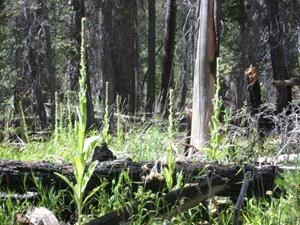
Utah State University/ Steve Dewey Plant Description
Woolly mullein, also known as Common mullein (Verbascum thapsus) is a biennial taprooted forb. Plants branch only when damaged and can grow to more than 8 ft (2.44 m) tall. First year plants appear as a rosette of leaves 4-12 in (10-31 cm) long, 1-5 in (3-13 cm) wide and covered with woolly hairs. The plant bolts in the second year. Flowering occurs in between July and October, when a dense spike of five-petaled, yellow flowers develops at the top of the shoot. Stem leaves alternate up the stem and decrease in size towards the apex. Native to Eurasia and Africa, woolly mullein was introduced to North America in the mid-1700s as a fish poison.

Habitat and Park Distribution
Mullein occurs throughout Lassen Volcanic NP typically under 6,500 ft elevation in yellow pine forests, lodgepole pine forests, mixed conifer forests, mountain shrublands and dry meadows. Mullein occurs primarily in coarse, well-drained soils in areas that have been disturbed in such a way as to increase sunlight reaching the ground. Within the park, it is most common on burned or cut slopes, along roads and trails, in gravel bars along waterways, and in developed areas such as campgrounds. It often occurs with or near bull thistle (Cirsium vulgare).

Ecology and Reasons for Concern
Mullein can invade any disturbed, sunny site with well-drained soils, including forests, shrublands, and meadows. Plants can form dense stands, slowing the recovery of native vegetation following fire, landslide, or other major disturbance. Over time, as woody plants recover to shade the ground and cover it with litter, mullein is gradually replaced by native herbaceous vegetation. However, mullein’s seeds can remain viable in the soil for decades, enabling the plant quickly to colonize any new disturbance. Lassen Volcanic NP uses fire as a tool to restore and maintain low-elevation forests, buring the understory every 10 to 20 years. This creates an open canopy and a sunny, disturbed ground surface ideal for mullein. Read more about the relationship between invasive plants and fire.
|
Last updated: February 28, 2015
